
The coyote is a species of canine native to North America. It is smaller than its close relative, the wolf, and slightly smaller than the closely related eastern wolf and red wolf. It fills much of the same ecological niche as the golden jackal does in Eurasia. The coyote is larger and more predatory and was once referred to as the American jackal by a behavioral ecologist. Other historical names for the species include the prairie wolf and the brush wolf.
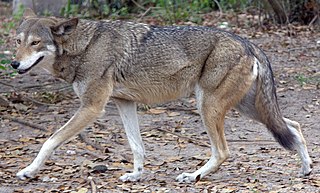
The red wolf is a canine native to the southeastern United States which has a reddish-tawny color to its fur. Morphologically it is intermediate between the coyote and gray wolf, and is very closely related to the eastern wolf of eastern Canada.

The bobcat, also known as the red lynx, is a medium-sized cat native to North America. It ranges from southern Canada, most of the contiguous United States to Oaxaca in Mexico. It is listed as Least Concern on the IUCN Red List since 2002 due to its wide distribution and large population. Although it has been hunted extensively both for sport and fur, populations have proven resilient though declining in some areas.
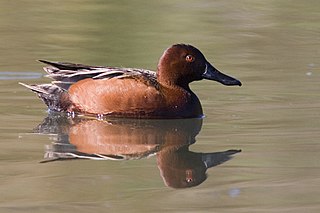
The cinnamon teal is a species of duck found in western North and South America. It is a small dabbling duck, with bright reddish plumage on the male and duller brown plumage on the female. It lives in marshes and ponds, and feeds mostly on plants.

The American badger is a North American badger similar in appearance to the European badger, although not closely related. It is found in the western, central, and eastern United States, northern Mexico, and south-central Canada to certain areas of southwestern British Columbia.

The Mexican wolf, also known as the lobo, is a subspecies of gray wolf native to southeastern Arizona, southern New Mexico, and northern Mexico; it also previously ranged into western Texas. It is the smallest of North America's gray wolves, and is similar to the extinct Great Plains wolf, though it is distinguished by its smaller, narrower skull and its darker pelt, which is yellowish-gray and heavily clouded with black over the back and tail. Its ancestors were likely the first gray wolves to enter North America after the extinction of the Beringian wolf, as indicated by its southern range and basal physical and genetic characteristics.

The painted buttonquail is a species of buttonquail, the family Turnicidae, which resemble, but are unrelated to, the quails of Phasianidae. This species is resident in Australia where numbers are believed to be in decline. A subspecies, the Abrolhos painted buttonquail, is endemic to the Houtman Abrolhos islands.
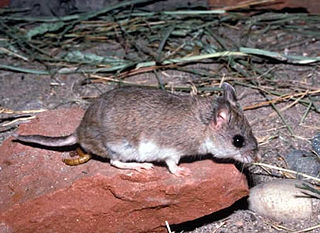
Mearns's grasshopper mouse or the Chihuahuan grasshopper mouse is a grasshopper mouse found in southwestern New Mexico, West Texas, and north-central Mexico. They are similar to Onychomys torridus, but differ in karyotype and size. This mouse is smaller in every regard except for the nasal length of the skull.
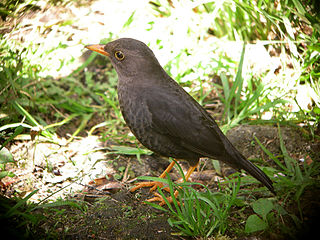
The island thrush is a common forest bird in the thrush family. Almost 50 subspecies have been described, ranging from Taiwan, through South East Asia and Melanesia, to Samoa, exhibiting great differences in plumage. Several subspecies are threatened and three have already become extinct.

The chestnut-backed chickadee is a small passerine bird in the tit family, Paridae.

The Mexican vole is a species of vole.

The yellow-bellied whistler, or Philippine whistler, is a species of bird in the family Pachycephalidae that is endemic to the Philippines.

Monardella villosa is a plant in the mint family which is known by the common name coyote mint.

The black-tailed jackrabbit, also known as the American desert hare, is a common hare of the western United States and Mexico, where it is found at elevations from sea level up to 10,000 ft (3,000 m). Reaching a length around 2 ft (61 cm), and a weight from 3 to 6 lb, the black-tailed jackrabbit is one of the largest North American hares. Black-tailed jackrabbits occupy mixed shrub-grassland terrains. Their breeding depends on the location; it typically peaks in spring, but may continue all year round in warm climates. Young are born fully furred with eyes open; they are well camouflaged and are mobile within minutes of birth, thus females do not protect or even stay with the young except during nursing. The average litter size is around four, but may be as low as two and as high as seven in warm regions.

Coyote Creek State Park is a state park of New Mexico, United States, preserving a riparian canyon in the Sangre de Cristo Mountains. The park is located 17 miles (27 km) north of Mora. Coyote Creek is the most densely stocked trout stream in New Mexico.
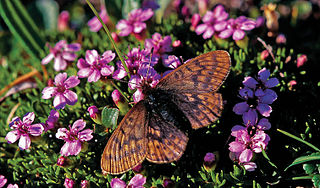
Boloria improba, the dingy fritillary, is a butterfly of the family Nymphalidae. In Europe it is only found in small parts of Scandinavia, more specifically the border region between Norway, Sweden and Finland. The species is also present in North America in the northeastern part of Alaska and some isolated populations in the Canadian part of the Rocky Mountains, southwestern Wyoming and southwestern Colorado. In Russia it is present in the northeast.

The Western moose is a subspecies of moose that inhabits boreal forests and mixed deciduous forests in the Canadian Arctic, western Canadian provinces and a few western sections of the northern United States. It is the second largest North American subspecies of moose, second to the Alaskan moose. This subspecies is prey to cougars, timber wolves, bears, and coyotes. Male Western moose are aggressive during mating season and may injure or kill with provocation.

The eastern coyote is a wild North American canine hybrid with both coyote and wolf parentage. The hybridization likely first occurred in the Great Lakes region, as western coyotes moved east. It was first noticed during the early 1930s to the late 1940s, and likely originated in the aftermath of the extirpation of the gray wolf in southeastern Ontario, Labrador. and Quebec, thus allowing coyotes to colonize the former wolf ranges, and mix with the remnant wolf populations. This hybrid is smaller than the eastern wolf and holds smaller territories, but is larger and holds more extensive home ranges than the typical western coyote.

The Plains coyote, also known as the brush wolf, is a subspecies of coyote native to the Canadian Prairies of southeastern Alberta, southern Saskatchewan, and the extreme southwestern corner of Manitoba. Its population in the United States occurs in South Dakota, Montana, Wyoming, Colorado, the northeastern corner of New Mexico; North Dakota ; northwestern Oklahoma, and the northern Texas Panhandle. It is the largest subspecies, with rather pale fur and bearing large molars and carnassials.

The northeastern coyote is a subspecies of coyote native to north-central Saskatchewan, Manitoba, southern Ontario, and extreme southern Quebec. Its population in the United States occurs along the eastern edge of North Dakota, Minnesota, Iowa, Missouri, Michigan, Wisconsin, Illinois, and northern Indiana. However, due to increased clearing of land for agriculture, the northeastern coyote has expanded its range throughout the entire state of Indiana. It is similar to C. l. latrans, or larger, but darker in color, and has a broader skull. The subspecies was first described by Hartley H. T. Jackson in 1949.




















